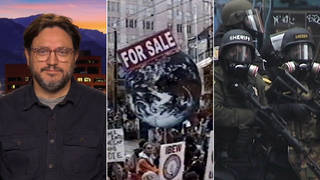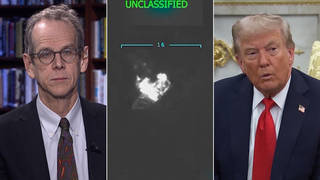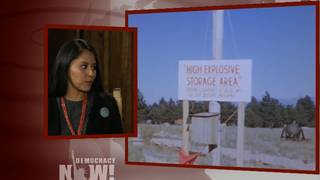
Guests
- Klee BenallyDiné (Navajo) activist. He is the former lead singer of the punk band Blackfire; founder of Outta Your Backpack Media collective, which teaches filmmaking to indigenous youth; and a volunteer with Clean Up the Mines!, a nationwide effort to clean up abandoned uranium mines.
- Taylor McKinnonenergy director of the Grand Canyon Trust.
The iconic Grand Canyon is the site of a battle over toxic uranium mining. Last year, a company called Energy Fuels Resources was given federal approval to reopen a mine six miles from the Grand Canyon’s popular South Rim entrance. A coalition of Native and environmental groups have protested the decision, saying uranium mining could strain scarce water sources and pose serious health effects. Diné (Navajo) tribal lands are littered with abandoned uranium mines. From 1944 to 1986, 3.9 million tons of uranium ore were chiseled and blasted from the mountains and plains of the region. More than 1,000 mines have closed, but the mining companies never properly disposed of their radioactive waste piles, leading to a spike in cancer rates and other health ailments. Broadcasting from Flagstaff, Arizona, we speak with Taylor McKinnon, director of energy with Grand Canyon Trust, and Klee Benally, a Diné (Navajo) activist and musician. “It’s really a slow genocide of the people, not just indigenous people of this region, but it’s estimated that there are over 10 million people who are residing within 50 miles of abandoned uranium mines,” Benally says. Benally also describes the struggle to preserve the San Francisco Peaks, an area considered sacred by 13 Native tribes, where the Snowbowl ski resort is using treated sewage water to make snow.
Transcript
AMY GOODMAN: “Song of the Sun” by Klee Benally. This is Democracy Now!, democracynow.org, The War and Peace Report. I’m Amy Goodman. Yes, we are on the road in Flagstaff, Arizona. Every year, millions of tourists flock here to visit the Grand Canyon, marvel at the spectacularly vast gorge carved out by the Colorado River. This natural wonder is a window into the Southwest region’s geological and Native American past.
Today the Grand Canyon is also the site of an ongoing battle over uranium mining. Last year, a company called Energy Fuels Resources was given federal approval to reopen a mine six miles from the Grand Canyon’s popular South Rim entrance. A coalition of Native and environmental groups have protested the decision, saying uranium mining could strain scarce water sources in the desert area and pose serious health effects.
Members of the Navajo Nations are all too familiar with the dangers posed by uranium mining, because their tribal lands are littered with abandoned mines. From 1944 to 1986, 3.9 million tons of uranium ore were chiseled and blasted from the mountains and plains of this region. Over the years, more than a thousand mines and four processing mills on tribal land closed. However, the mining companies never properly disposed of their radioactive waste piles, leading to a spike in cancer rates and other health ailments.
This is a clip from the documentary The Return of Navajo Boy about Navajo who have suffered health problems due to environmental contamination.
LORENZO BEGAY: My mom and my Uncle Bernie were just little kids when their mom and their grandma both got lung disease.
BERNIE CLY: [translated] I remember we lived by the mines. Uranium was in the water we used for washing and drinking. This is how we lived. One day, Mom went to the hospital. Us kids waited all summer for her to come home. Harry Goulding came and told us that Mom died. Grandma started to cry, “My daughter…”
AMY GOODMAN: That’s a clip from the award-winning documentary film, The Return of Navajo Boy, produced by Jeff Spitz and Bennie Klain.
Well, for more on the uranium mining in this region and other environmental challenges, we continue our conversation with Taylor McKinnon, director of energy with Grand Canyon Trust, and with Klee Benally, a Diné, or Navajo, activist. He’s the former lead singer of the punk band Blackfire; founder of Outta Your Backpack Mediacollective, which teaches filmmaking to indigenous youth; and a volunteer with Clean Up the Mines!, a nationwide effort to clean up abandoned uranium mines.
Taylor McKinnon, as well as Klee Benally, again, welcome. Klee, talk more about what the Navajo, the Diné people, are facing.
KLEE BENALLY: Yá’át’ééh abíní. And first of all, thank you and welcome to the racist state of Arizona and the slightly racist, slightly less racist city of Flagstaff. We have been challenged with resource colonization in this area for many years. It’s really the battle—the geopolitics here are rooted in racism. They’re rooted in the corporate greed that we continue to face this day. More than 20,000 Diné, or Navajo, people have been forcibly relocated from our homelands because of Peabody Coal’s activities on Black Mesa, and we have an estimated more than 1,000 abandoned uranium mines on our lands. In 2005, the Diné, or Navajo, Nation decided to ban all uranium-mining activities on our lands. But today, we have tribal council representatives who are really just selling our future away and trying to lift this ban. And so we, at this point, are in a situation where there have been no meaningful health studies on the impacts of uranium mining in our community.
AMY GOODMAN: Give us an example of what one of these abandoned mines look like.
KLEE BENALLY: Well, I was actually just in Cameron, about 40 minutes away from here, yesterday with Taylor McKinnon doing a presentation. And just about 50 feet away from the chapter house, which is the local government area in this area, there is an abandoned uranium mine that is a—looks like a hill. I mean, contaminated radioactive dirt looks like regular dirt. It’s an invisible threat. But there were toys. There were—from what I understand, there were signs of children playing in this hill, and there were houses just right the base of this. But one of these rocks, when a Geiger counter was set on it, it went through the roof. And so, these abandoned uranium mines look like the rest of the natural landscape.
AMY GOODMAN: And there are how many?
KLEE BENALLY: There are an estimated over a thousand in our homelands. But there are estimated to be over 10,000 abandoned uranium mines throughout the whole United States, and it’s primarily within 15 Western states. But the EPA has never done a meaningful inventory on these threats that are really a toxic legacy that impacts us to this day. It’s really a slow genocide of the people, not just indigenous people of this region, but it’s estimated to be that there are over 10 million people who are residing within 50 miles of abandoned uranium mines.
AMY GOODMAN: Taylor, what is Grand Canyon Trust doing about this?
TAYLOR McKINNON: We’ve been largely focused on efforts by the uranium industry to develop new mines on public lands. And since the mid-2000s, when the price of uranium spiked, we’ve seen a real resurgence of uranium-mining activity in northern Arizona. So we’ve been—we led the charge to compel the—alongside a number of different tribal and conservation and community partners, to compel the Obama administration to enact a ban on new mining in Grand Canyon’s watersheds. That went into effect in 2012. However, it did not apply to old mines, mines that were built in the 1980s. And we’ve seen federal agencies—the Bureau of Land Management and the Forest Service—allow three of those mines to reopen without undertaking new public or environmental reviews. They’re relying on their 1980s reviews, and thus effectively ignoring reams of new science about the potential impacts of those mines to groundwater, to aquifers that feed springs in the Grand Canyon, that are critical for wildlife, that are held sacred by Native peoples, and that form all of, except for the Colorado River, the perennial surface water in the Grand Canyon. These are—
AMY GOODMAN: Let’s turn to another clip from the film, The Return of Navajo Boy, the award-winning documentary produced by Jeff Spitz and Bennie Klain about the Cly family, Navajo who have suffered health problems due to environmental contamination. Here, we hear more about the impact of uranium mining on the Navajo community, on the Diné people.
DINÉ WOMAN: [translated] We live in the midst of uranium. We walk upon it every day. Our houses are built with it. It’s in our walls.
KERR-McGEE OIL INDUSTRIES PROMOTIONAL FILM: Royalties from the uranium mines are providing much-needed cash for the Navajo prospector and for the tribe. Many of the Navajo men are employed in the uranium mines, where they are valued as conscientious workers.
LORENZO BEGAY: The mining company didn’t tell our fathers and uncles that uranium could kill them or they would be used to make atomic bombs.
AMY GOODMAN: Again, that’s a clip from The Return of Navajo Boy. Klee, what are families told? What are communities told? I mean, we’re dealing with, one, the abandonment of a thousand uranium mines, but then also the building of more now.
KLEE BENALLY: Well, the EPA has a five-year plan that was initiated to clean up these abandoned uranium mines. But the reality is, is that these mines are not being cleaned up. The EPA is turning these abandoned sites into containment or to waste dumps that are toxic, that are hazardous, that are still leaching contaminants into our waterways, that are still impacting our grazing lands and our sheep and so forth. And we have abandoned uranium mines and threatened new proposed uranium mines in proximity to our sacred sites, which are vital for our way of life, for our cultural identity. So we are being told that—essentially, the message that we are sent is, is that our—the impacts to our health, our well-being and who we are in our sacred lands is not meaningful enough to have serious cleanup.
AMY GOODMAN: How do the rules work, because of the different laws on Native American reservations?
KLEE BENALLY: Well, the cleanup is a slow process. It’s a complex process. And I think that it is challenging in relation to the current law on the rez, but we have to look at the reality that, as I mentioned before, there are more than 10,000 abandoned uranium mines throughout the U.S. There are some areas where the abandoned mines or new proposed mines are located in close proximity to our reservation lands. They’re on public—they’re on private lands, and they leach toxic contaminants. The dust, the toxic particles, blow into our communities. And we have no control. We have no way to regulate that. I mean, for example, in Church Rock, New Mexico, where in 1979 one of the largest toxic spills happened in U.S. history, there’s still nothing that has really been done to clean up. There’s new proposed mines happening outside of our tribal lands, right off the borders. So, this is a very complex issue. There are multiple agencies that are involved. And what we end up seeing happen is, is that our future gets railroaded over in the interests of corporate greed.
AMY GOODMAN: Can you talk briefly about the San Francisco Peaks and what they are, for people who have never heard of them?
KLEE BENALLY: Doko’oo’sliid, or the holy San Francisco Peaks, are holy to more than 13 indigenous nations. They are central for our cultural survival.
AMY GOODMAN: Where are they?
KLEE BENALLY: They’re located just right outside of Flagstaff, and they’re the highest point in northern Arizona. You can see the Grand Canyon from them. You can see just such a beautiful landscape. And they’re vital not only for our cultural practices, but they’re an ecological island that are home to endemic species such as the San Francisco Peaks ragwort, which is only found on the San Francisco Peaks and nowhere else in the world.
AMY GOODMAN: And what’s happening with them?
KLEE BENALLY: Well, right now, we’re—for the past 30 years—really, for the past 20 years, it’s been a heated battle to protect this mountain from resource extraction and development, and not just talking about coal, uranium, oil, natural gases, but recreation as a resource extraction on these sacred lands. The San Francisco Peaks are managed by the United States Forest Service as public land, and currently they lease part of those lands to a ski resort known as Arizona Snowbowl, that is—
AMY GOODMAN: Snowbowl?
KLEE BENALLY: Snowbowl. And they’ve permitted to expand their development into rare alpine forests, clearcutting more than 30,000 trees, many of them old-growth. And the most controversial part is that they’ve entered into a contract with the city of Flagstaff. The politicians of Flagstaff have sold 180 million gallons of treated sewage per year for snow making. And this, right—
AMY GOODMAN: Of sewage?
KLEE BENALLY: Of treated sewage for snow making.
AMY GOODMAN: So this is greywater?
KLEE BENALLY: Well, it’s considered treated sewage, or reclaimed water. And so, in this case, there are harmful contaminants that are not tested or treated for by the EPA that are allowed to be in this wastewater, and it’s being sprayed on this sacred church of ours. Right now, even though we’ve had more than 10 years of legal battles that have gone all the way to the Supreme Court, the situation is that we don’t have guaranteed protections for religious freedom as indigenous people. And Snowbowl has become—in 2011, they became the first ski area in the world to make snow out of 100 percent treated sewage effluent.
AMY GOODMAN: Taylor, is there any legal means to challenge this?
TAYLOR McKINNON: Well, it’s not an issue that Grand Canyon Trust has worked on. I know that the Hopi Tribe has ongoing legal challenges in state court and federal court.
AMY GOODMAN: So, are the Navajo—Klee, are the Navajo and Hopi working together on this?
KLEE BENALLY: We had a coalition of 14 indigenous nations actually working together on this with six environmental groups, that had led the charge to defend this sacred mountain on cultural and environmental grounds. But those challenges failed in the Supreme Court. And so it reaffirmed that we, as indigenous people, don’t have guaranteed protection for our religious freedom. And that’s the situation we’re in now. I’ve been arrested multiple times trying to stop the excavators up on this mountain, and that seems to be the only redress that we really have.
AMY GOODMAN: I wanted to turn to one last clip from this film, The Return of Navajo Boy, the film that’s produced by Jeff Spitz and Bennie Klain. Here, we learn about water scarcity and contamination on Diné land.
LORENZO BEGAY: The community water pump is about five miles from my mom’s house. We all get our drinking water from the same place. There’s about 200 people who live in this area. It takes about 10 minutes to fill one barrel. My niece Sherri learns to be patient filling the barrels. The government came here a few years ago to check the safety of our drinking water, but they never came back with the results.
AMY GOODMAN: That’s a clip from the film that we have been playing through this segment, The Return of Navajo Boy. Klee Benally, the scarcity of water?
KLEE BENALLY: So, the framing of this section, I understand, is the winners and losers of these struggles. But there are no winners when we destroy Mother Earth. When we destroy the water that we need to drink, then we destroy the air that we need to breathe and the ground that we need to feed ourselves from. And so, right now, the EPA has closed 22 wells that have been determined to have too high of levels of toxic contaminants in them on the Navajo Nation. But many of our people don’t have running water; they don’t have electricity. Yet our lands have been exploited. We have coal-fired—three coal-fired power plants that pollute our air. We have these abandoned uranium mines and new mines that are threatening the region. We have fracking, hydraulic fracking, that’s threatening our land, as well. But this isn’t just an issue for here. Wherever there’s an environmental crisis, there’s a cultural crisis, because we are people of the Earth. This is a social crisis that everybody has some impact of, because when we look at the larger challenges of global warming, global warming, from an indigenous perspective, is just a symptom of how we are out of balance with Mother Earth. So this is a problem that’s all over.
AMY GOODMAN: Talk about how climate change affects indigenous people.
KLEE BENALLY: Well, we see the threats of displacement of indigenous people from the waters that are rising and depopulating villages that were on islands. We see the threat of the caribou migrations and those impacts. And we see this key resorts that feel like they need to make snow because they don’t have enough natural snow, and so they desecrate sacred mountains such as this. I mean, the—it’s not—we are all indigenous to this land, to somewhere, on our mother, the Earth. And so, these impacts impact us all.
AMY GOODMAN: And, Taylor, finally, the effect of climate change on the Colorado River area and the Grand Canyon?
TAYLOR McKINNON: Researchers have projected declines in flow of up to 30 percent in the coming century, owing to climate change and other factors. And so, in a time when we’re—the Colorado Plateau and the Colorado River Basin and its water users stand to lose the most, it’s a time for this region also to look very carefully at the energy choices that we’re making.
AMY GOODMAN: I want to thank you both for being with us. Taylor McKinnon is with the Grand Canyon Trust. Klee, I’d like you to stay with us for our next segment. Klee Benally, Diné, Navajo, activist, the former lead singer of the punk band Blackfire. We’re also, when we come back, going to be joined by Alex Soto, who will talk about indigenous organizing on the border. He is a member of the Chicano-indigenous hip-hop duo Shining Soul. Stay with us.












Media Options